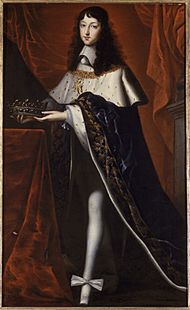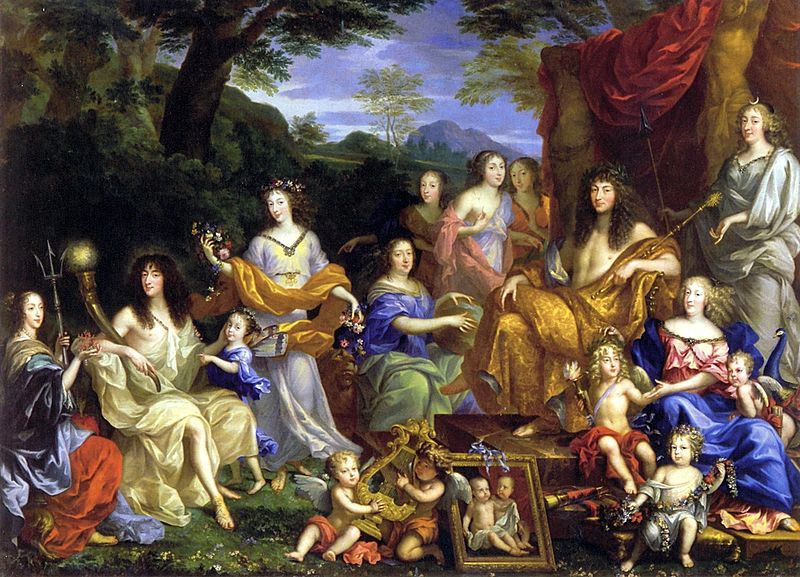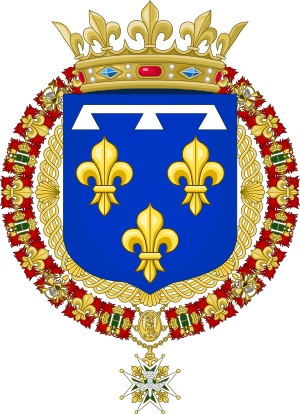Philippe I, Duke of Orléans facts for kids
Quick facts for kids Philippe I |
|||||
|---|---|---|---|---|---|
| Duke of Orléans | |||||
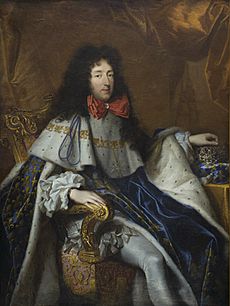
Portrait by Pierre Mignard
|
|||||
| Born | 21 September 1640 Château de Saint-Germain-en-Laye, France |
||||
| Died | 9 June 1701 (aged 60) Château de Saint-Cloud, France |
||||
| Burial | 21 June 1701 Basilica of St Denis, France |
||||
| Spouse | |||||
| Issue Detail |
|
||||
|
|||||
| House | Bourbon (by birth) Orléans (founder) |
||||
| Father | Louis XIII of France | ||||
| Mother | Anne of Austria | ||||
| Religion | Catholicism | ||||
| Signature | 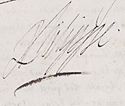 |
||||
Philippe I, Duke of Orléans (born September 21, 1640 – died June 9, 1701), was a French prince. He was the younger son of King Louis XIII of France and Anne of Austria. His older brother was the famous "Sun King," Louis XIV.
From birth, Philippe was known as the Duke of Anjou. He became the Duke of Orléans in 1660 after his uncle Gaston passed away. In 1661, he also received the titles of Duke of Valois and Duke of Chartres. After a military victory in 1671, Louis XIV gave his brother even more titles, including the dukedom of Nemours.
Philippe married twice. First, he married Henrietta of England, and then Elizabeth Charlotte of the Palatinate. He had several children with them. Philippe founded the House of Orléans, which was a branch of the ruling House of Bourbon. This means he was a direct ancestor of Louis Philippe I, who ruled France from 1830 to 1848. Philippe was also a military leader, notably at the Battle of Cassel in 1677. He managed his money and properties very well, which made the House of Orléans very rich.
Contents
Early Life of Philippe
Philippe's Birth and Childhood

Philippe was born on September 21, 1640, at the Château de Saint-Germain-en-Laye in France. This was the day before his mother Anne's 39th birthday. As the son of the king, he was called a Fils de France (Son of France). He was second in line to the French throne, right after his older brother Louis.
He was baptized privately soon after birth and named Philippe. King Louis XIII wanted to give him the title Count of Artois. This was to celebrate a French victory in Arras. But he followed tradition and gave Philippe the title Duke of Anjou instead. This title was often given to younger sons of French kings.
Growing Up as Le Petit Monsieur
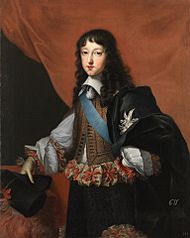
When their father Louis XIII died in May 1643, Philippe's older brother became King Louis XIV. Their mother, Queen Anne, took full control of her children. Philippe was called le Petit Monsieur (the Little Monsieur). This was because his uncle Gaston, who was also a king's younger brother, was still alive and known as le Grand Monsieur (the Great Monsieur). Philippe became known simply as Monsieur or the Duke of Orléans after Gaston died in 1660.
Philippe was seen as a charming and smart child. He spent some of his childhood at the Hôtel de Villeroy in Paris. In 1647, at age seven, Philippe got smallpox but recovered. A year later, he was publicly baptized at the Palais Royal. His godparents were his uncle Gaston and his aunt Queen Henrietta Maria of England.
His education focused on languages, history, literature, math, and dancing. His mother and Cardinal Mazarin watched his behavior closely. They made sure he did not have too much financial freedom from the crown.
When Philippe was eight, a civil war called the Fronde began in France. The royal family had to leave Paris for safety. When peace returned, Philippe moved his household to the Palais des Tuileries. At Louis XIV's coronation in 1654, Philippe helped place the crown on his brother's head. Philippe always loved formal ceremonies and made sure all details were correct.
In 1658, Louis XIV became very ill. Philippe, as the next in line to the throne, became the center of attention. Queen Anne showed more affection to her younger son during this time. After Louis recovered, Philippe was left to himself again. Later in 1658, Philippe bought the Château de Saint-Cloud, a large estate near Paris. He immediately started making improvements to the building.
Becoming Duke of Orléans
When Philippe's uncle Gaston died in February 1660, the Duchy of Orléans returned to the crown. Gaston had no sons who survived. This duchy was a very important title. It was traditionally given to the king's brother. So, Philippe became the Duke of Orléans. Louis XIV officially gave him the title on May 10, 1661. He also received the titles of Duke of Valois and Duke of Chartres.
To prevent rivalry between Philippe and the king, Queen Anne and Cardinal Mazarin limited Philippe's ambitions. He was not given much financial freedom from the crown. Philippe wanted to add more lands, like the countship of Blois, but his brother refused.
Marriages and Family Life
First Marriage: Princess Henrietta of England
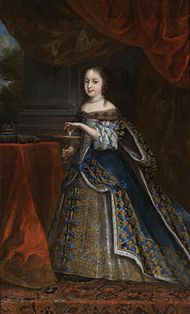
After Louis XIV married in 1660, Queen Anne focused on Philippe's marriage. Philippe was encouraged to marry his older cousin, Anne Marie Louise d'Orléans, Duchess of Montpensier. She was very rich, but she refused, saying Philippe acted "like a child."
Instead, Philippe married another cousin, Princess Henrietta of England. She was the youngest child of King Charles I of England. Henrietta had lived in France after her birth in 1644. In 1660, she returned to England to visit her sister. The French court officially asked for Henrietta's hand for Philippe in November 1660. Their marriage contract was signed on March 30, 1661, and the ceremony was the next day. Henrietta was known as Henriette d'Angleterre in France and Minette to her friends. She was very popular at court.
The couple moved to the Palais Royal in 1662. In March of that year, Philippe became a father. Henrietta gave birth to their daughter, Marie Louise, who later became Queen of Spain. Henrietta was disappointed it was a girl. But Philippe always considered Marie Louise his favorite child.
In 1664, Henrietta had a son, who was named Duke of Valois. Philippe wrote to his brother-in-law, King Charles II of England, about the "fine boy." However, the child died in 1666. This loss greatly affected Henrietta. Philippe, however, was more concerned with keeping the allowance his son had received from the king.
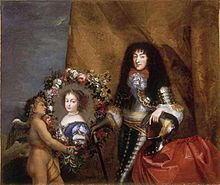
Philippe fought in the War of Devolution in 1667. He showed bravery in battles at Tournai and Douai. But he soon became more interested in decorating his tent than fighting. He returned home when Henrietta was ill from a miscarriage. After she recovered, Philippe went back to battle and fought well at the Siege of Lille.
In 1670, Henrietta helped convince the king to imprison the Chevalier de Lorraine. He was a close friend of Philippe's. Philippe was angry about this and went to his estate at Villers-Cotterêts, taking Henrietta with him. Philippe's protests eventually convinced the king to bring the Chevalier back. Henrietta and Philippe had their last child, a daughter named Anne Marie, in August 1669.
Henrietta is known for helping to arrange the Secret Treaty of Dover in 1670. This treaty was between England and France. It meant France would help England rejoin the Catholic Church. England would help France in a war against the Dutch Republic. After returning to France, Henrietta faced Philippe's anger about the Chevalier's exile and her secret mission. She became ill at Saint Cloud and died on June 30, 1670, at age 26. An autopsy showed she died from a perforated ulcer. However, some people believed she was poisoned.
| Painting commissioned by Philippe for Saint Cloud, Jean Nocret, 1670 |
|---|
Second Marriage: Princess Elizabeth Charlotte
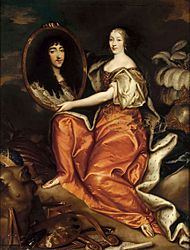
Henrietta's death was mourned at court, but not much by Philippe due to their difficult relationship. Louis XIV looked for a second wife for Philippe. Philippe wanted a son to continue his family line. Louis XIV considered many women before choosing Elizabeth Charlotte of the Palatinate. She was a Protestant princess, known as Liselotte to her family.
Marriage with Princess Palatine Elizabeth Charlotte

Philippe married Elizabeth Charlotte, who became Catholic, on November 16, 1671. She was not considered as beautiful as Henrietta. However, she became popular at court for her honest and straightforward nature. Her letters show that she agreed to sleep in separate beds from Philippe after their children were born. She also quietly accepted the presence of his male friends in their home.
The couple was happy in their early marriage years. Elizabeth Charlotte gave birth to a son in June 1673, named Alexandre Louis. He was given the title Duke of Valois but died in 1676. A second son, Philippe, was born in 1674. Then a daughter, Élisabeth Charlotte, was born in 1676. After this, they decided to sleep in separate beds. Elizabeth Charlotte was a good mother. Philippe's second son, Philippe, later became the Regent of France when Louis XV was a child. Elizabeth Charlotte was like a mother to Philippe's children from Henrietta.
Military Success at Cassel
Philippe had already shown he was a good military leader in the War of Devolution in 1667. He was eager to fight again. In 1676 and 1677, he took part in sieges in Flanders. He was promoted to lieutenant general, making him second-in-command to Louis XIV.
| "The people of Paris went wild with joy. They really love Monsieur. But at court they'd wished he'd lost the battle for the king's sake..." |
| From the memoirs of Primi Visconti |
Philippe's most impressive victory was on April 11, 1677, at the Battle of Cassel. He fought against William III, Prince of Orange. William tried to help some towns under siege. Philippe learned of William's plans and prepared to meet his forces. Louis XIV sent Philippe more soldiers. The Dutch attacked without scouting first. Philippe's forces surprised them with a cavalry attack. This attack destroyed many battalions and defeated William's army.
Philippe was praised for his military skills. This made his brother, the king, somewhat jealous of Philippe's growing popularity. After this victory, Philippe ended his military career. He then focused on a life of enjoyment and his estates.
Expanding Estates and Art Collection
After his victory at Cassel, Philippe focused on expanding his estates and art collection. He renovated his homes, the Palais Royal and the Château de Saint-Cloud. Saint-Cloud was his favorite home. Philippe supported artists like Jean Nocret and Pierre Mignard. They helped decorate Saint-Cloud and the Palais Royal.
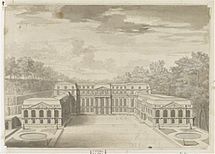
Philippe also hired Antoine Lepautre to start additions at Saint-Cloud. Later, Mansart designed a grand staircase there. The gardens were redesigned by André Le Nôtre. By the time Philippe died in 1701, the Saint-Cloud estate covered about 1200 acres. This estate stayed with the Orléans family until 1785.
Minor improvements at the Palais Royal began in 1661. Philippe could not do much to renovate it until it was given to him in 1692. He again asked Mansart for help to modernize it. In 1695, Philippe bought a small island in the Seine river across from the château. He renamed it the "Île de Monsieur."
Philippe loved architecture, music, and dancing. He was known for his excellent dancing. He supported musicians like Anglebert and Dumont. Philippe's small art collection became the start of the Orleans Collection. This was one of the most important art collections ever.
Philippe also sponsored projects to make his estates more profitable. In 1679, he was allowed to build the Canal d'Orléans. This large canal connected the Loire river to other canals. It was a major engineering achievement for its time. The canal was used to transport goods from Orléans to Paris. It was very successful and is still used today. Philippe's smart investments made him very wealthy. His fortune grew even more when his cousin Mademoiselle died in 1693. Philippe is known as the founder of the House of Orléans. He also made the family financially strong, rivaling the main House of Bourbon.
Later Years and Passing
When Mademoiselle died in 1693, Philippe gained more titles. These included the Dukedoms of Montpensier and Châtellerault. In his later life, Philippe easily maintained his lavish lifestyle. He found joy in the activities of his children and grandchildren. Both of his daughters from his first marriage married important European rulers and became queens. His son, the Duke of Chartres, had a successful military career. He fought at the Battle of Steenkerque in 1692. Philippe was very proud of him.
| "I won Monsieur over during the last three years of his life. We even used to laugh together about his weaknesses... He had confidence in me and always took my side, but before that I used to suffer dreadfully. I was just beginning to be happy when the Almighty took poor Monsieur from me" |
| Elizabeth Charlotte of the Palatinate writing in 1716 about her affection for Philippe in their later years. |
In 1696, Philippe's granddaughter Marie-Adélaïde came to the French court. She married Louis, Duke of Burgundy, who was third in line to the throne. They married in 1697 and later became the parents of Louis XV. In 1701, Chartres was not allowed to fight in the War of the Spanish Succession. This upset both Philippe and his son greatly.
On June 8, 1701, Louis XIV and Philippe met to dine. Louis XIV criticized Philippe about his son Chartres's behavior. Philippe responded by reminding Louis of his own past behavior. The argument stopped for dinner.
Philippe returned to Saint Cloud that evening to dine with his son. He collapsed and died from a stroke on June 9, 1701, at age sixty. Louis XIV was very sad, saying he would "never see my brother again." Philippe's heart was taken to a convent. His body was buried at the Basilica of St Denis.
Elizabeth Charlotte was worried she would be sent to a convent. But the king assured her she could stay at court. She burned all of Philippe's old letters to protect his privacy. Louis XIV told the new Duke of Orléans, Philippe's son, that the past was forgotten. Elizabeth Charlotte continued to write to her daughters and stepdaughters. She died at Saint Cloud in December 1722 and was also buried at Saint Denis.
Portrayals in Media
Philippe has been shown in many modern films and TV shows:
- The Private Life of Louis XIV (1935 film), played by Hans Stüwe
- Liselotte of the Palatinate (1966 film), played by Harald Leipnitz
- The Taking of Power by Louis XIV (1966 film), played by Pierre Pernet
- Marquise (1997 film), played by Franck de La Personne
- Vatel (2000 film), played by Murray Lachlan Young
- Charles II: The Power and the Passion (2003 mini-series), played by Cyrille Thouvenin
- Le Roi Soleil (2005 musical), played by Christophe Maé
- A Little Chaos (2015 film), played by Stanley Tucci
- Versailles (2015 TV series), played by Alexander Vlahos
Issue
Children from First Marriage
Philippe married his cousin, Princess Henrietta of England, on March 31, 1661. They had three children who survived infancy:
- Marie Louise d'Orléans (March 26, 1662 – February 12, 1689) married Charles II of Spain. They had no children.
- Philippe Charles d'Orléans, Duke of Valois (July 16, 1664 – December 8, 1666) died as a baby.
- Anne Marie d'Orléans (August 27, 1669 – August 26, 1728) married Victor Amadeus II, Duke of Savoy (who later became King of Sardinia). They had children.
Children from Second Marriage
Philippe married Elizabeth Charlotte of the Palatinate on November 16, 1671. They had three children:
- Alexandre Louis d'Orléans, Duke of Valois (June 2, 1673 – March 16, 1676) died as a young child.
- Philippe II, Duke of Orléans (August 2, 1674 – December 2, 1723) married Françoise Marie de Bourbon. They had children.
- Élisabeth Charlotte d'Orléans (September 13, 1676 – December 24, 1744) married Leopold, Duke of Lorraine. They had children.
Images for kids
See also
 In Spanish: Felipe I de Orleans para niños
In Spanish: Felipe I de Orleans para niños
- Descendants of Philippe I, Duke of Orléans


